1. Convert the binary data “011010” into analog wavefor
Added on 2022-11-16
15 Pages2725 Words1 Views
End of preview
Want to access all the pages? Upload your documents or become a member.
Modulation Techniques, CRC, Spread Spectrum, WLAN, TCP/IP, Cellular Communications
|13
|2058
|340
Modulation Techniques for Binary Data
|15
|1797
|74
Wireless Communication
|16
|817
|455
Amplitude Shifting Keying and Frequency Shift Keying
|16
|1420
|253
Comparison of Different Modulation Techniques and Error Detection Process
|17
|2315
|81
Wireless Network and Communication
|12
|980
|335




